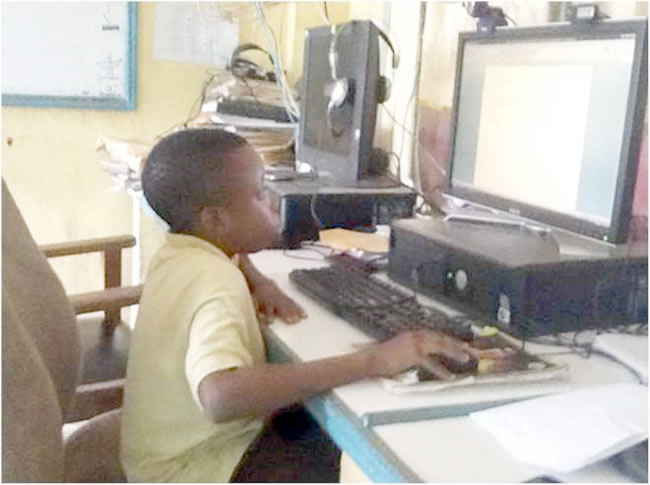People living with autism face different clinical and behavioural challenges. ADEOLA OTEMADE x-rays some of these challenges and how autistic people can be integrated into the socio-economic space, especially, in a post-pandemic world.
Autism is a unique developmental condition which often occurs in the first three years of life and is triggered by a neurological disorder that alters the brain’s normal functioning, limiting social interaction, communication, and imaginative skill development. Autism affects both children and adults in terms of verbal and nonverbal communication, social interactions, and leisure and play activities.
According to a publication entitled “Autism in Nigeria: A Call for Action” published by Journal of Clinical Sciences, one out of between 125 and 150 children in Nigeria has autism. Thus, approximately 600,000 Nigerian children are affected. The cost to the child, his or her family, society, and the nation as a whole is impossible to quantify, not just in terms of social services but also in terms of GDP.
It is no understatement, therefore, to note that people with autism have always experienced challenges and suffer social setback over the years, as they often find it difficult to fit into everyday social and economic life of their societies. Thus, the World Autism Awareness Day is held annually, specifically every April 2, as it was done last weekend, to draw attention to these and several other issues affecting them.
The case of ZizahObiohaOkeugo, a 13-year-old visual artist with autism, exemplifies the difficulties faced by autistic persons in their social life. Zizah was a non-verbal, reclusive child in his early years. He endured continual training in speech development, motor skill development, and numerous emotional control strategies after his diagnosis at the age of four to assist him blend into a non-autistic world.
Gradually, he became interested in art and music and began to utilise them to communicate with others and convey his thoughts and feelings. His method is simply observation, listening, and paying close attention to the environment around him before creating art that speaks for him.
A different scenario played out in the case of 16-year-old Christine Mike-Nnaji. For the first four years of her life, she never spoke a word. However, she could rock back and forth between Barney and Friends, a children television series. Her parents later enrolled her in a private school.
Functions of the Mind
OluwadamilolaAlawode, a registered Conduct Technician and Clinical Supervisor at the Zeebah Foundation, while speaking with the Sunday Tribune, on autistic children said that some of the behavioral characteristics of those living with Autism include trouble initiating conversations and repetitive behavior.
“Children with autism are frequently identified at an early age, usually between the ages of two and four. During this time, the youngster is unable to speak or initiate communication, making it difficult for them to interact with their surroundings.
“Children with autism prefer to do things in a predictable pattern, such as rolling their heads, flapping their hands, rocking their bodies, or putting their toys in a regular rhythm. They only do what they want to do because it is what they want to do.
“They tend to throw tantrums, go into fistful rage such as hitting their head against the wall or flinging themselves on the ground, if they are not attended to. This is due to their inability to communicate their emotions and feelings through speech, which leads to repetitious behaviour. As a result, when they seek assistance, they may be misunderstood by others around them,” Alawode explained.
These manifestations, according to MoyoMaitanmi, a psychiatrist doctor at the Federal Nero Psychiatric Hospital, Lagos, are defined by discrepancies or irregularities in communication.
She said: “Differences or anomalies in communication and social interaction, confined and repetitive interests or patterns of behavior, intellectual incapacity, atypical sensory perception, mood swings, and possibly self-harming conduct, define these illnesses.”
A paediatrician, Doctor OladipoAkinnuyi, also told Sunday Tribune that the clinical manifestations of autism in children include developmental regression, language delay, lack of symbolic play, and stereotyped behavior.
Speaking further, she noted that the problems include “developmental regression, linguistic delays and deviations, lack of symbolic play, repetitive and stereotyped conduct, lack of smiling when parents or family members greet them.”
Others according to her are: “An abnormal response to stimuli in the environment, delayed peer contacts, few or no friendships, and little engagement, delayed peer interactions, few or no friendships, and little interaction,” adding that other observed indices are “delay in verbal communication without compensatory nonverbal communication (e.g. gestures), imaginative and social imitative play (that is postponed routines), rigidity, and conservatism.”
Autism Caused by Various Factors
In Dr. Maitanmi’s view, the specific cause of Autism Spectrum Disorder (ASD) is unknown because there is no single reason that can be adduced to it. She, however, explained further that certain genetic mutations and metabolic disorders are probable contributors.
“The specific cause of Autism Spectrum Disorder (ASD) is uncertain. According to the most recent study, there is no single cause. In having an autistic immediate family member, certain genetic mutations, fragile X syndrome and other genetic disorders, being born to older parents, low birth weight, metabolic imbalances, exposure to heavy metals and environmental toxins, and a maternal history of viral infections are all suspected risk factors for ASD. Other factors, according to her include “Valproic acid or thalidomide exposure during pregnancy.”
Doctor OladipoAkinnuyi, in his own view, also stated that though there is no specific factor responsible, “scientific evidence suggests that it is caused by a complex combination of many genetic and environmental factors that makes a child more likely to develop autism,” and that it is a highly hereditary condition. He added that: “Autism spectrum disorder is related with 10–15 percent of other known genetic illnesses such as Fragile X syndrome, Rett syndrome, and tuberous sclerosis.”
Road to integration
According to Dr. Akinnuyi, integration of people living with autism into the society including the workplace, could be made easier provided managerial modalities and early social and communication-based intervention programs are made available.
“Adopting management methods as soon as an autism diagnosis is made is one way for people with autism to integrate smoothly into society and the workplace. Multidisciplinary management should include a behavioural and educational approach, as well as information and support for the family in the form of a family care plan. Autism can be managed well with early social and communication-based intervention programmes.
“To make things easier in the area of communication, there are already in place educational curricula for autistic children, such as TEACCH -Treatment and Education of Autistic and related communication handicapped children; STAR – teaching methodologies based on autism research, and parent training; visual augmentation such as pictures and objects, as well as extensive training.
“To address a wide range of specific behaviours in children and young people living with autism, behavioral interventions such as discrete trial instruction, pivotal response training, and relationship development intervention should be considered, both to reduce symptom frequency and severity and to increase the development of adaptive skills.
“In addition, occupational therapy plays a critical role in assisting people with autism to operate successfully in society,” he explained.
Mrs. DotunAkande, the Founder and Director of Patrick Speech and Languages Centre Ikeja, Lagos, stated that children and people with autism can be integrated into society and the workplace by identifying what makes them unique, as well as how best they communicate their feelings, as some of them have difficulties with verbal and nonverbal communication, social interactions, and leisure or play activities.
“Some of them are gifted and talented, and these scaled abilities must be nurtured, respected, and celebrated. Art is one of these pastimes, through which these persons can find solace and a long-term job that will improve their quality of life.
Participation in the arts has been shown to improve student achievement in all subject areas, according to research,” she said
Creating awareness in the society is of essence because there are many children and young adults living weith autism but due to perceived stigma, many live shut away from social interaction.
According to Dr. Maitanmi, the society should be aware that it is a treatable condition and that it is nothing to be ashamed of.
“Raise societal awareness of the occurrence of a condition known as autism. This aids in the reduction of stigma and labeling. Educate people about the risk factors, their causes, symptoms, and how to manage them. The universities and maternity homes are good places to start. Let them be aware that they can seek help and support from hospitals, (neuropsychiatric hospitals), non-governmental organizations, and religious organisations. There are unique residences and schools available. Families with such children should be provided additional incentives while adults and parents who abuse such children should be punished,” she said.
In her submission, Dr. Alawode asserted that society should keep in mind that children with autism may not reach the same developmental milestones as non – autistic developing children because they are delayed in growth, have communication problems, and take longer to achieve their milestone.
“They are delayed in their growth and they are unable to reach out for things they want. They would eventually get there, but not at the age they were expected to. It’s hard for them to integrate into the environment they find themselves. Autistic people don’t get to know what they want, meanwhile a neuro-typical developing person (child not affected by autism) finds it challenging to relate with autistic children as they are unable to understand them, it takes more time to learn but they would eventually learn,” she said.
Treating autism
According to professionals, autism is a treatable disorder, but due to the ignorance of certain people, they assume that is how such a child is, or that it is not natural, and they seek spiritual help and other forms of treatment.
When autism is left untreated, according to Alawode, the child becomes a thorn in the flesh for both family and society at large.
“A toddler who only knows how to scream at the top of his lungs or throw tantrums when they are ignored may grow up to be violent. There might be an outbreak, and the options are endless.
“When it comes to autism, there may be an explosion; the options are unlimited; a child who does not speak could be left silent; they would be unable to fit in. It would be extremely harmful to society.
“Parents should look beyond the diagnoses and seek aid for their children. Early intervention is critical; make sure kids get help and learn the skills they need. Autism can be treated and people with autism can be taught more useful ways to behave in society.
“Parents notice their problems before they notice their children; they are children before they are diagnosed. They learn at a different rate than other kids and would prefer to learn at their own pace. As autistic children, they deserve to be loved and given all the assistance they require; some can’t tie their shoelaces, others can’t speak; they either point at objects or throw tantrums if not responded to. They deserve to be loved and given all the care they require,” she explained.
There are also implications of having uncared for autistic children in the society. Dr. Moyo said of the impact on society: “Implications of these if left untreated can lead to death, poor quality of life, and an increase in the degree of comorbidity. More money is spent on treating the condition, and children are physically and sexually mistreated, resulting in physical injuries, undesired pregnancies, STDs, and other social vices such as criminality, alcohol and substance addiction, and dangerous sexual practices, among other things.”
Acceptance of autistic patients
“People with autism are commonly stigmatised and discriminated against, including unjust deprivation of health care, education, and opportunity to fully interact and participate in their cultures,” says Dr. Akinnuyi.
Continuing he said: “The public needs to be aware of a simple fact: everyone, including those with autism, has the right to the best possible physical and mental health. People with autism, in my opinion, should be given more priority and care because they are more likely to develop chronic medical conditions as a result of behavioral risk factors such as physical inactivity, and they are more prone to violence, injury, and abuse.
Resolutions to encourage everyone’s optimal health, participation in society, and well-being people with autism have long been reached. In many summits around the world, the 67th World Health Assembly, for example, had adopted a resolution entitled Comprehensive and coordinated efforts for the management of autism spectrum disorders in May 2014, which calls on WHO to work with Member States and partner agencies to strengthen national capacities to address autism and other developmental disabilities.
Two of the World Health Organization’s adopted resolutions also state that “promoting inclusive and enabling environments for people with autism and other developmental disabilities, as well as providing support to their caregivers” and “increasing governments’ commitment to taking action to improve the quality of life of people with autism” will help people with autism have optimal social inclusion and acceptance.”
However, the implementation of these resolution, especially in developing countries of the world has not lived up to the billing expected by both the WHO and World Health Assembly.






